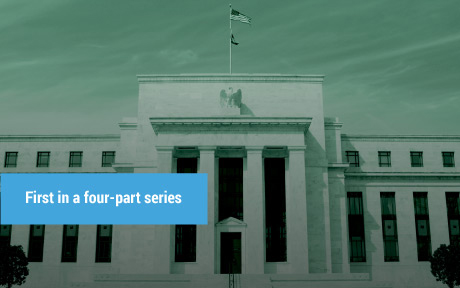Hey, Economist! Outgoing Advisor Antoine Martin Reflects on How His New York Fed Perch Has Shaped His Work

Antoine Martin, an economist and financial stability advisor in the New York Fed’s Research and Statistics Group, will soon take up a new post at the Swiss National Bank (SNB), as head of its third department covering money markets/foreign exchange (FX). In that role, Martin, who is originally from Switzerland, also becomes one of three members of that central bank’s rate-setting governing board. Readers of Liberty Street Economics will be familiar with his byline, as he has written more than sixty posts presenting new research findings and policy analysis, all with an eye for breaking down the most complicated topics in clear terms. He took a few questions from publications editor Anna Snider about his experiences and future plans as he prepares to move on.
The Federal Reserve’s Two Key Rates: Similar but Not the Same?

Since the global financial crisis, the Federal Reserve has relied on two main rates to implement monetary policy—the rate paid on reserve balances (IORB rate) and the rate offered at the overnight reverse repo facility (ON RRP rate). In this post, we explore how these tools steer the federal funds rate within the Federal Reserve’s target range and how effective they have been at supporting rate control.
Size Is Not All: Distribution of Bank Reserves and Fed Funds Dynamics

As a consequence of the Federal Reserve’s large-scale asset purchases from 2008-14, banks’ reserve balances at the Fed have increased dramatically, rising from $10 billion in March 2008 to more than $2 trillion currently. In that new environment of abundant reserves, the FOMC put in place a framework for controlling the fed funds rate, using the interest rate that it offered to banks and a different, lower interest rate that it offered to non-banks (and banks). Now that the Fed has begun to gradually reduce its asset holdings, aggregate reserves are shrinking as well, and an important question becomes: How does a change in the level of aggregate reserves affect trading in the fed funds market? In our recent paper, we show that the answer depends not just on the aggregate size of reserve balances, as is sometimes assumed, but also on how reserves are distributed among banks. In particular, we show that a measure of the typical trade in the market known as the effective fed funds rate (EFFR) could rise above the rate paid on banks’ reserve balances if reserves remain heavily concentrated at just a few banks.
Implementing Monetary Policy Post‑Crisis: What Do We Need to Know?
Columbia University’s School of International and Public Affairs and the New York Fed co-sponsored a recent workshop to discuss important issues related to monetary policy implementation. The May 4 event, held at Columbia, supports the extended effort that the Federal Reserve has undertaken to evaluate potential long-run monetary policy implementation frameworks, which was announced at a Federal Open Market Committee meeting last July.
Standard Elements of a Monetary Policy Implementation Framework

Emily Eisner, Antoine Martin, and Ylva Søvik In the minutes of the July 2015 Federal Open Market Committee (FOMC) meeting, the chair indicated that Federal Reserve staff would undertake an extended effort to evaluate potential long-run monetary policy implementation frameworks. But what is a central bank’s monetary policy implementation framework? In a series of four […]
Corridors and Floors in Monetary Policy
As part of its prudent planning for future developments, the Federal Open Market Committee (FOMC) has discussed strategies for normalizing the conduct of monetary policy, when appropriate, as the economy strengthens.










 RSS Feed
RSS Feed Follow Liberty Street Economics
Follow Liberty Street Economics